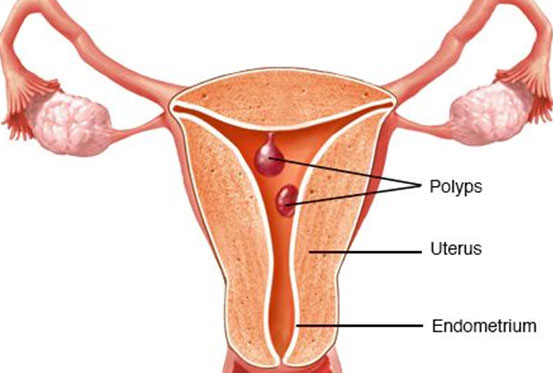Uterine Polyps
Uterine polyps are growths in the uterus that attach to the inner uterine wall and extend into the cavity. Polyps usually are noncancerous, but on occasion, can be cancerous or turn into cancer. The size of uterine polyps varies and can be anywhere between a few millimeters to many centimeters.

SYMPTOMS
Most women that have uterine polyps don’t display any symptoms at all, while some experience spotting to heavy bleeding. The most common signs and symptoms of uterine fibroids include:
- Irregular menstrual bleeding (frequent, unpredictable periods)
- Bleeding between menstrual periods
- Excessively heavy menstrual periods
- Vagina bleeding after menopause
- Infertility
CAUSES
While the cause of uterine polyps remains unknown, we do know that they are influenced by hormonal factors because they are estrogen-sensitive. For example, increasing levels of estrogen can cause uterine polyps to grow. Risk factors for developing uterine polyps include:
- Being perimenopausal or postmenopausal
- High blood pressure
- Obesity
- Taking Tamoxifen (medication for breast cancer)
DIAGNOSIS
Uterine polyps can be detected by performing one of the following tests:
- Ultrasound:the presence of uterine polyps can be detected by using a transvaginal probe to capture images of the uterine cavity. If a thickening of the endometrial tissue is visualized, this can suggest uterine polyps.
- Hysterosonography (fluid test): polyps can also be seen by imaging, with a transvaginal probe, when saline water is injected into the uterus through a thin catheter to expand the cavity and show any irregularities.
- Hysteroscopy: for a more in-depth look at the uterus, polyps can be visualized through a lighted telescope that is inserted through the cervix and to the uterus. After injecting saline and expanding the cavity, the uterine walls are scoped out for any presence of a polyp.
- Endometrial biopsy:confirmation of uterine polyps can be made via lab testing after using a suction catheter to obtain a specimen in the uterine cavity.
TREATMENT
Depending on being symptomatic or not, uterine polyps are either treated by observation alone or treated with hormonal medication, and/or surgery to remove them completely. For polyps that are symptomatic and/or become problematic, they can be removed surgically during a hysteroscopy. Once the polyp is removed, it is then sent to the lab for testing to determine if the polyp has cancerous cells or not.
You will need the Adobe Reader to view and print these documents. 